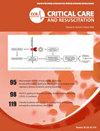Prone positioning of nonintubated patients with COVID-19 in Australian intensive care units
IF 1.4
4区 医学
Q3 CRITICAL CARE MEDICINE
引用次数: 0
Abstract
Objective
To describe the use of and outcomes from awake prone positioning (APP) in nonintubated patients with COVID-19 in Australian intensive care units (ICUs) in comparison to those who did not receive APP, and to explore the temporal relationship between publication of APP research and changes in clinical practice.
Design
Multicentre, observational cohort study.
Setting
Seventy-eight Australian ICUs participating in SPRINT-SARI Australia.
Participants
Adult patients with confirmed COVID-19 admitted to ICU from 27 February 2020 until 30 June 2022.
Main outcomes measures
Proportion of patients receiving APP, rates of invasive ventilation, hospital length of stay (LOS), in-hospital mortality.
Results
4711 patients were included in the analysis, of whom 28.6% (1347/4711) underwent APP. Use of APP rapidly increased during the Delta wave and then subsequently declined. Over this period, there were a total of 30 publications on APP. APP patients received a median of 2 (IQR 1–4) days prone positioning, were less unwell (median APACHE-II 13.0 vs. 15.0, p < 0.001), and were less likely to require invasive ventilation (27.9% vs. 34.9%, p < 0.001). Overall, there was no difference in hospital LOS (median 14 vs. 13 days, P = 0.420) or in-hospital mortality (HR 0.95, 0.8–1.11) in those that did and did not receive APP. However, in patients requiring invasive ventilation after their first day in the ICU, not receiving APP was associated with earlier time to intubation (median 1 vs. 3 days, p < 0.001) and lower adjusted in-hospital mortality (HR 0.70, CI 0.54–0.90).
Conclusions
APP was rapidly adopted into practice within Australian ICUs during the COVID-19 pandemic at the same time as a growing number of publications on the topic. A lower frequency of invasive ventilation was noted with APP overall, but in those who eventually required this intervention, APP was associated with greater risk-adjusted in-hospital mortality.
澳大利亚重症监护病房非插管COVID-19患者俯卧位
目的:比较澳大利亚重症监护病房(icu)非插管的COVID-19患者与未接受APP的患者清醒俯卧位(APP)的使用情况和结果,探讨APP研究发表与临床实践变化之间的时间关系。设计:多中心、观察队列研究。背景:78名澳大利亚icu参加SPRINT-SARI澳大利亚。参与者:2020年2月27日至2022年6月30日入住ICU的成年COVID-19确诊患者。主要结局指标:接受APP的患者比例、有创通气率、住院时间(LOS)、院内死亡率。结果:4711例患者纳入分析,其中28.6%(1347/4711)患者接受了APP治疗。APP的使用在Delta波期间迅速增加,随后下降。在此期间,共有30篇关于APP的出版物。APP患者接受俯卧位的中位数为2 (IQR 1-4)天,不适较少(APACHE-II中位数13.0 vs. 15.0, p)。结论:在COVID-19大流行期间,APP在澳大利亚icu中迅速被采用,同时有关该主题的出版物也越来越多。总的来说,APP患者有创通气的频率较低,但在最终需要这种干预的患者中,APP与更高的经风险调整的住院死亡率相关。
本文章由计算机程序翻译,如有差异,请以英文原文为准。
求助全文
约1分钟内获得全文
求助全文
来源期刊

Critical Care and Resuscitation
CRITICAL CARE MEDICINE-
CiteScore
7.70
自引率
3.40%
发文量
44
审稿时长
>12 weeks
期刊介绍:
ritical Care and Resuscitation (CC&R) is the official scientific journal of the College of Intensive Care Medicine (CICM). The Journal is a quarterly publication (ISSN 1441-2772) with original articles of scientific and clinical interest in the specialities of Critical Care, Intensive Care, Anaesthesia, Emergency Medicine and related disciplines.
The Journal is received by all Fellows and trainees, along with an increasing number of subscribers from around the world.
The CC&R Journal currently has an impact factor of 3.3, placing it in 8th position in world critical care journals and in first position in the world outside the USA and Europe.
 求助内容:
求助内容: 应助结果提醒方式:
应助结果提醒方式:


